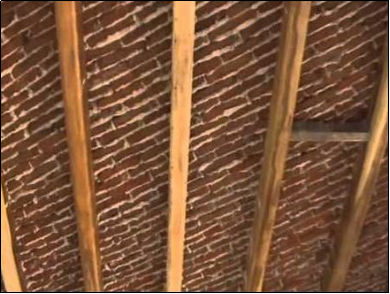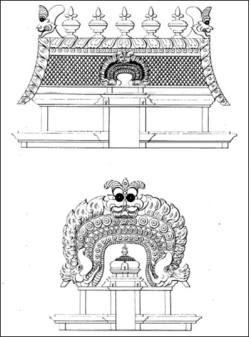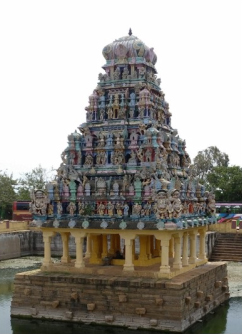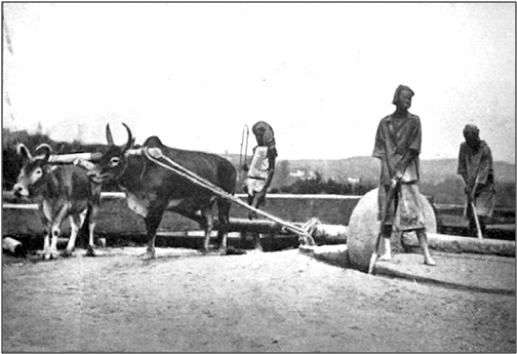Registered with the Registrar of Newspapers for India under R.N.I 53640/91
Vol. XXIX No. 20 , February 1-15, 2020
Marble-like Chunnam in 18th- and 19th- Century Madras Presidency
by Dr. A. Raman
Lime (calcined limestone), referred as çûnam (‘chûnnam’) was used in the Indian subcontinent for ages. In the Tamizh country, lime was referred as çûnnãmpu. Thomas Lehmann explained the etymology of çûnnãmpu as follows:
‘The word çûnnãmpu is first attested in the 12th century war poem Kalingathu-p-parani According to the Tamil Lexicon of the University of Madras çûnnãmpu is derived from çûnnã (Prakrit). It is possible that the word çûnnãmpu was in use before the 12th Century.
The nature and quality of chûnnam used in the Madras Presidency are formally recorded in various published reports by the British either living in or visiting Madras from the 18th Century. All of them consistently remark that the quality of this material used in building human residences and other buildings was superior than that used for the same purpose elsewhere in India.
James Anderson of Hermiston comments in an article on chûnnam (1799, p. 7): ‘No cement for building hath as yet been discovered in Europe that can be compared with the fine Chunam of India for closeness, toughness, durability, and beauty. It sets as quickly as stucco, and at the same time acquires a hardness greatly superior to our best lime mortar, and is alike proper for works underwater, as for those that are exposed to the air; so that it supersedes the use alike of gypsum and of puzzuolana, or terras.’
Reverend James Cordiner, a teacher at the Male Military Orphan Asylum in Madras between June 1798 and April 1799, and later Chaplain at the Government House, Colombo (Sri Lanka), while returning to Britain in 1802 from Colombo via Madras, comments appreciatively on the quality of chûnnam used in the then newly constructed Banqueting Hall and a few other new buildings in Madras. He also clarifies that the sparkling chûnnam was made by mixing lime and unrefined sugar – the jaggery1 – in particular proportions, so that the chûnnam-finished walls were beautiful, enduring and sparkled like marble.
Walter Hamilton in his travelogue – the Geographical, Statistical, and Historical Description of Hindostan, and the Adjacent Countries (1820) says (p. 193): Chunam, or lime, occurs in extensive quantities among the boundary hills, and is accessible during the rains, from whence it is transported by the inland navigation to the most distant parts of Bengal; but it is greatly inferior to the beautiful shell-chunam of Madras. A commerce in chunam, wax, ivory, and other articles, is carried on with the Cosseahs2 and other mountaineers on the eastern frontiers of Bengal.’
Maria Callcott, a popular British writer and traveller of the 19th Century and one who lived in Madras and Bombay in 1809–1811, describes in her book The Essays towards the History of Painting (1836, p. 220):
‘Panænus3 (the brother of Phidias) used a plaster or stucco in the Temple of Minerva at Elis, Southern Greece, mixed with milk. This should be something like the beautiful marble-like stucco or chunam-work of India. I once saw a floor laid at Madras, among the materials of which were jaggree (jaggery) or coarse sugar, water and milk.’
Because of its quality and shine, the Madras chûnnam was preferentially chosen for use in several buildings in Singapore in the mid-19th Century. The Government House and St. Andrew’s Cathedral are two classic examples. To carry out this task, convicts deported from Madras, who were familiar with the technology, were used as labour.
 Inside view of Madras-terrace roof. Wooden rafters hold the diagonally-laid baked, slender, red half-bricks (arai-k-kal) plastered along their left–right and front–back faces (Source: https://www.pinterest.com.au/pin/36697306-
Inside view of Madras-terrace roof. Wooden rafters hold the diagonally-laid baked, slender, red half-bricks (arai-k-kal) plastered along their left–right and front–back faces (Source: https://www.pinterest.com.au/pin/36697306-9635001123).
The Madras Terrace Roofs, unique construction using chûnnam
Madras chûnnam was used both for fixing bricks and plastering wall exteriors. A popular component of human residences from the early decades of the 18th Century Madras was the ‘Madras terrace roof’ (MTR). Before the popularity of MTR in the 18th Century, houses of middle- and low-income earners were essentially thatch roofed,using interwoven sun-dried plant materials (e.g., grasses and palm foliage) laid tightly on bamboo frames. MTRs were constructed using baked, red bricks plastered with lime mortar, placed diagonally over 30–45 cm apart-wooden rafters. If considered necessary, the MTRs were supported by wooden pillars.
 Above: Ornate chûnnam work on the sikarã of the vimãnã of a temple in the Madras presidency (Source:nRãz 1834, plate xxvi. Lithograph by William Day and Louis Haghe, London.Artist not identified).
Above: Ornate chûnnam work on the sikarã of the vimãnã of a temple in the Madras presidency (Source:nRãz 1834, plate xxvi. Lithograph by William Day and Louis Haghe, London.Artist not identified).
Below: Neerazhi mandapam(the hall in the middle of the temple tank) adjacent to the Chithira Sabai of Tiru-k-kutralanãthar temple management, Courtallam. The 3-storey tower bears beautiful çunnãmpu sculptures. Estimated construction was either during the Vijayanagara Empire (14th–17th Centuries) or during the reign of the Madurai Nayak-s
(16th–17th Centuries). Recently colour-washed because of a festive event in the Tiru-k-kutralanãthar temple. (Photo: A. Raman, July 2018.)

1. Jaggery is the unbleached, raw sugar from sugarcane juice (Saccharum officinarum, Poaceae). Jaggery is also made from Asian Palmyra (Borassus flabellifer, Arecaceae) by extracting and boiling the sap that oozes from the cut end of either the shoot bud or the inflorescence. It is the most abundantly available sugar source widely used by the less welloff rural people of India (Playne et
al., 1914–1915).
2. Cosseahs — people belonging
to the Khasi Hills of the Shillong
Plateau, Meghalaya (Nongsiej
2002).
3. Panænus: a painter in ancient
Greece (c. 500 BC) (Leake 1821).
Frederick Hemingway (Collector and Magistrate of Trichnopoly [Tiruchirapalli]), comments on the houses in the district Tiruchirapalli in the first decade of the 20th Century (1907, p. 81):
‘The houses of the poor are thatched. Persons of even moderate wealth build themselves terraced or tiled houses. Terraced houses are rare in Namakkal and Udaiyarpalaiyam taluks, where tiles are generally used. Terraced houses, in many other districts, are usually owned only by the wealthy. Two-storied houses are perhaps more common in this than in most other districts. Thatch is made of plaited cocoanut leaves covered with straw of various kinds. Occasionally a loft or mud terrace called kurangumacchu (a kind of mezzanine) is built beneath the roof. Houses are generally oblong in shape.’
Engineer John Thomas Smith and the Lime Mortar of Madras
John Smith (1805–1882), chief engineer with the Madras Engineers Corps (MEC), is immortalised in Madras for designing and building the Grecian-Doric column lighthouse in 1838–1839. Smith explored the science of limes and lime mortar used as building material. Many of the classy engineering papers and reports submitted to the government at Fort St. George (Madras) by MEC staff were published in the Reports, Correspondence and Original Papers on Various Professional Subjects Connected with the Duties of the Corps of Engineers Madras Presidency,edited and published by him from 1839. These papers enlighten us on some of the remarkable science that flourished in Madras.
1. Jaggery is the unbleached, raw sugar from sugarcane juice (Saccharum officinarum, Poaceae). Jaggery is also made from Asian Palmyra (Borassus flabellifer, Arecaceae) by extracting and boiling the sap that oozes from the cut end of either the shoot bud or the inflorescence. It is the most abundantly available sugar source widely used by the less well-off rural people of India (Playne et al., 1914–1915).
2. Cosseahs — people belonging to the Khasi Hills of the Shillong Plateau, Meghalaya (Nongsiej 2002).
3. Panænus: a painter in ancient Greece (c. 500 BC) (Leake 1821).
 Mortar mill used while building the Government House, Singapore.
Mortar mill used while building the Government House, Singapore.(Source: McNair and Bayliss, 1899)
(to be continued next fortnight)

